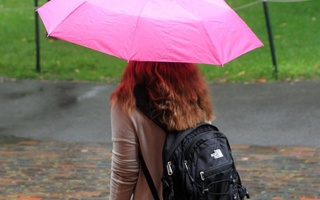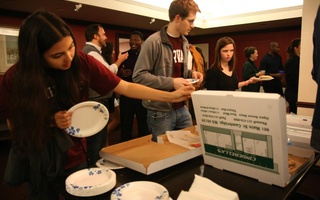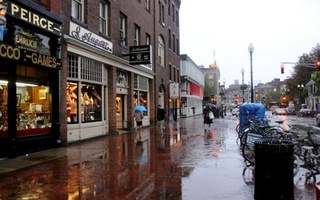During a long, cold December bus ride to Logan airport, I thought about home. I thought about Harvard. And I thought about what the difference was.
It was the beginning of winter break, and I was heading back through the rainy Boston air to the place I grew up in, near Los Angeles, where the only regular precipitation comes from child actors who cry over the absence of FIJI water in their trailers (these are called “El Spoiled Niño” storms or “Temperature Tantrums”). In Southern California, winter is summer, fall is summer, spring is summer, and Summer is the name of every bikini-clad girl tanning along the shoreline. After a semester of being introduced to new concepts like “snow,” “sweaters,” and “visible breath,” I couldn’t wait to get back.
I flew in late, drove for a while, and slept on my old bed. Once I awoke, I rushed to the window in hopes that a beautiful floating ball of hot plasma would greet me with its warmth once again. I closed my eyes, threw open the shades, and looked out. Darkness. Clouds. Rain. Misery.
The sight warmed my heart.
There’s something different about Southern California rain—it’s comforting. In my suburban hometown of Thousand Oaks, it trickles over the hills and valleys. They are covered in light shadows, and the streets become paved in the gritty shine of wetness. The air grows cool and smells fresh and sweet as people fill it with ridiculous complaints about how they have to rewash their SUVs because of the rain. On the other hand, rain at Harvard is an annoying normality. It just makes the elegance of the Yard and Square seem kind of dirty.
Small things about a community, like the rain, are different at Harvard than at other places. And first-year students like myself, many traveling home for the first time this past month since leaving for college, reflect on those differences and on whether Harvard can be considered a second home. There are many comparisons, but the most important aspect of a community (or home) is the people. I feel at home with Southern Californians. For the most part, they are all warm, friendly and, like I said before, named Summer, which is a very pretty name for both genders. But the people at Harvard, each coming from such different backgrounds geographically, ethnically, academically, racially or otherwise, are harder to characterize. And as if that wasn’t tricky enough, each has also stood out as students and citizens from their backgrounds; there aren’t any “stock characters” defined by their community. In that sense, Cambridge becomes a place to go for people who don’t quite fit in—a home for the homeless—which is kind of what it already was.
So, Harvard students go into freshman year sharing just a few qualities—intellectual curiosity, a motivation to succeed, and what seems like a fetish-level fascination for boat shoes. But they don’t share much else. Unlike the homes they come from, not everyone has grown up together in similar circumstances. Student groups are often at odds with one another. Conversations can get awkward fast. Regional words like “hella” and “wicked” quickly become weird and then faux pas. Some freshman rooming groups fit together like peas in a missile pod, choosing never to talk to one another. Overall, not much meshes together very well.
The result can sometimes feel like Harvard is a collection rather than a community—an active museum where the students, rare finds in themselves, all share the same space (most of which does look like museum space) while doing their own activities and following their own pursuits. It often seems like everyone is too busy being talented or achieving something to go for a day trip to Boston or play a game of touch football. And that disjointedness doesn’t always feel too homey.
But that disjointedness is actually what can make it homey. The fact that not everyone fits together nicely defines Harvard as a community. One reason the admissions office tries to create a diverse class is because research shows students learn better in diverse communities. And that’s because we learn from the ways in which we don’t fit together, and those awkward connections can lead to unlikely, deep, and funny interactions between friends who, against all odds, were brought together by the College. Everyone and every day is different. Just like the rain in Southern California, it’s a nice surprise—a homey one.
As I moved back into the dorm this past week for the coming semester, I looked out the window. Darkness. Clouds. Snow. Misery. Students were plopping back on campus as the snow accumulated at their feet. I turned back inside. Some of my entryway-mates—one a New York dancer and rower, one a flautist, one a pundit, one an aspiring science writer, and the list goes on—were having a long, tantalizing conversation about nothing. I looked back through the window at the freezing rain with a confused look on my face. My friend said, “That’s called a ‘flurry,’ Dash.” Another new word. I smiled.
Harvard is many things. For some it’s a prestigious, multicultural, intellectual, and self-absorbed institution for new and old elites. For others it’s just another liberal arts college. But for me, and I’m sure for many other freshman and upperclassmen coming back for another semester, it’s a second, rainy home.
Dashiell F. Young-Saver ’16, a Crimson editorial writer, lives in Grays Hall.
Read more in Opinion
Future of the Social Choice Fund
















